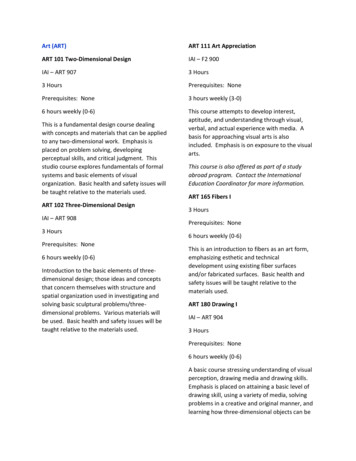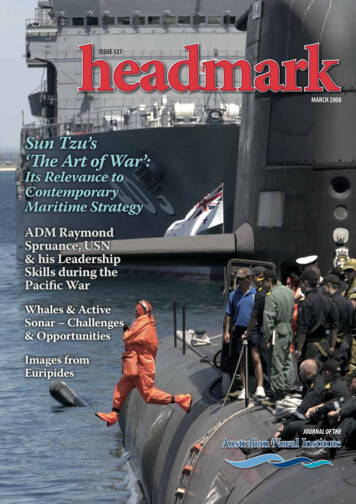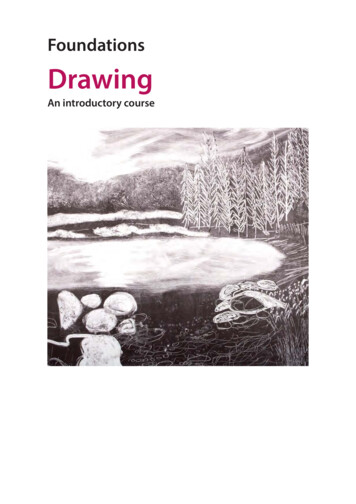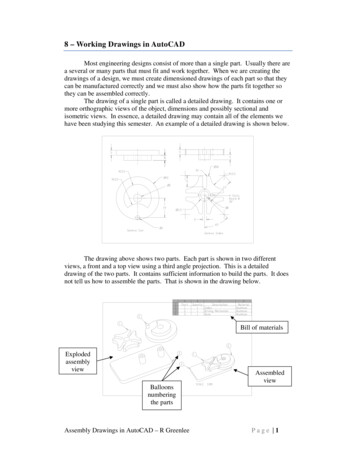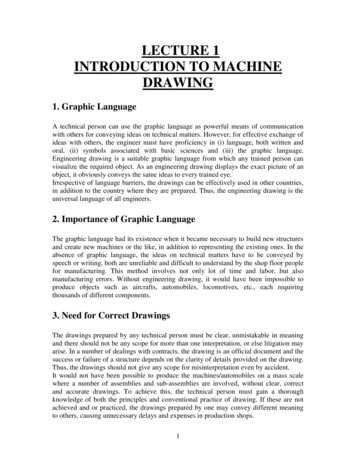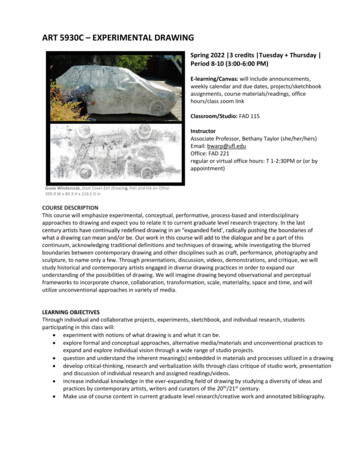
Transcription
ART 5930C – EXPERIMENTAL DRAWINGSpring 2022 3 credits Tuesday Thursday Period 8-10 (3:00-6:00 PM)E-learning/Canvas: will include announcements,weekly calendar and due dates, projects/sketchbookassignments, course materials/readings, officehours/class zoom linkClassroom/Studio: FAD 115InstructorAssociate Professor, Bethany Taylor (she/her/hers)Email: bwarp@ufl.eduOffice: FAD 221regular or virtual office hours: T 1-2:30PM or (or byappointment)Gosia Wlodarczak, Dust Cover Ezri Drawing, Pen and Ink on Other209.9 W x 84.3 H x 216.5 D inCOURSE DESCRIPTIONThis course will emphasize experimental, conceptual, performative, process-based and interdisciplinaryapproaches to drawing and expect you to relate it to current graduate level research trajectory. In the lastcentury artists have continually redefined drawing in an “expanded field’, radically pushing the boundaries ofwhat a drawing can mean and/or be. Our work in this course will add to the dialogue and be a part of thiscontinuum, acknowledging traditional definitions and techniques of drawing, while investigating the blurredboundaries between contemporary drawing and other disciplines such as craft, performance, photography andsculpture, to name only a few. Through presentations, discussion, videos, demonstrations, and critique, we willstudy historical and contemporary artists engaged in diverse drawing practices in order to expand ourunderstanding of the possibilities of drawing. We will imagine drawing beyond observational and perceptualframeworks to incorporate chance, collaboration, transformation, scale, materiality, space and time, and willutilize unconventional approaches in variety of media.LEARNING OBJECTIVESThrough individual and collaborative projects, experiments, sketchbook, and individual research, studentsparticipating in this class will: experiment with notions of what drawing is and what it can be. explore formal and conceptual approaches, alternative media/materials and unconventional practices toexpand and explore individual vision through a wide range of studio projects. question and understand the inherent meaning(s) embedded in materials and processes utilized in a drawing develop critical-thinking, research and verbalization skills through class critique of studio work, presentationand discussion of individual research and assigned readings/videos. increase individual knowledge in the ever-expanding field of drawing by studying a diversity of ideas andpractices by contemporary artists, writers and curators of the 20th/21st century. Make use of course content in current graduate level research/creative work and annotated bibliography.
COURSE OUTLINE:Project will be roughly two weeks apart – from research and process to final product and critique.Project descriptions, due dates and grading criteria will be posted on e-learning.PROJECT 1:Drawing Connections: Material, Space and Language Accumulation/Translation (semester long research/drawing book project)In this project, students will visit the Harn Museum during class on Tuesday, January 11. Students will‘collaborate’ with an artwork of their choice creating a connection/response by transforming elements of thework of art into the creation of a new drawing(s). A research handout given at the museum visit will guidestudents in conceptualizing the project. This visit will also be a catalyst for semester-long experiments indrawing to be archived in your research/drawing book.PROJECT 2:Performative Drawing: Ambitious Gestures, Control and Abilities of the BodyWe will experiment with ways of using our bodies to draw and generate meaning. We will physically explorethe connection between movement and drawing and will look to artists who have used their entire bodies tocreate marks.PROJECT 3:Chance Drawing: Collaborating with the UncontrollableWe will alternate between being the author and spectator in the creative process.PROJECT 4:Drawing Intermediaries: The Space In-BetweenWe will look to artists who use intermediaries (unconventional tools/objects/media between the hand andsubstrate/paper) to create drawings as inspiration for our own projects.PROJECT 5:Trans-Inter-disciplinary Drawing: Communicating, Translating, Exploring, and Generating HybridityWe will explore a dissolution of disciplinary boundaries and utilize drawing to integrate knowledge andmethods from different disciplines, using a synthesis of approaches.*For each project you will need to write a short artist statement and take high-quality documentation photos.RESEARCH/DRAWING BOOK*collected/graded at mid-term and end of semester with periodic pop-up checks.You will keep a research/drawing book for this class as a record of thoughts and visual ideas generated by projectsworked on throughout the semester. Research/Drawing Books should include ideas, compositional sketches, materialor color explorations, experiment logs, proposals, propositions, notes from lectures, discussions, and critiques,independent artist research and any other ideas of interest to you. It should be bursting with any and allideas/energy generated throughout semester.In addition, an important part of each project grade will include attendance, process and research throughout thecourse of the project timeline. As evidence of research/process, you will take in-process photos and scans of yoursketchbook to upload to canvas to accompany each project.
Accumulation/Translation Project (on-going research/drawing book assignment)This project will be a semester-long daily probing of a single artwork you selected from the Harn Museum at the startof the semester. This research/drawing book assignment will ask us to consider accumulative strategies of analyzing,translating and making. Minimum expectations are evidence of daily probing/gestures including:writing/research/poetry/critical review, sketching structure, studies of hue, value, chroma, materials, processes,concepts, research into related artists or influences, collected ephemera, printed or found, and other relatedexperiments. By revisiting the same artwork, for even 5-10 minutes daily, out of familiarity, surprisingideas/revelations emerge.By working every day, even in small ways, we are able to realize ambitious gestures, and by interacting with yourresearch/drawing book on a consistent basis, a sincere archive and chronology of the evolution of your ideas will bethe greatest reward.ARTIST PRESENTATIONS(As a graduate student in the course) You will pick two artists (instead of one required of undergrads)) from a listcompiled (posted on-learning). Your presentation will be a maximum of 15 minutes in length with at least twentyquality images arranged in a Powerpoint presentation. Your goal is to give the class a strong and informativeintroduction to a contemporary artist’s creative practice -- this includes intent/motivation, meaning, andprocesses. Presentation tips will be provided prior to deadline. These presentations will be scheduled to occurthroughout semester. You will sign-up for a time/date on a google doc that will be posted on e-learning.CLASS EFFORT/STUDIO TIMEThe effort that you invest in this class will be reflected in your work. The grade you earn will also reflect this timeand effort. You will be held accountable to the potential I see in you and your work. Please make a commitmentto this studio course and you will be rewarded with exciting growth in your art practice. This commitment toyourself and our collective learning community requires cooperation, hard work, dedication, creativity, selfmotivation, and perhaps most critically - being open to input and new ideas and a willingness to receivementorship.CRITICAL THINKING, CLASS PARTICIPATIONActive participation, support and respect in all phases of this course are imperative. The learning communitydynamic depends on your energy, initiative, attitude, productivity and willingness to get involved in groupdiscussion and critique. This includes the depth and quality of your participation in group discussions (askingquestions and formulating responses), performance in critiques (analyzing and providing constructive criticism foryour peer’s work and your own), and the ability to accept, analyze and digest advice and suggestions.DIVERSITY STATEMENTIt is my intent that we explore the content of this course in a way that is respectful of diversity: gender identity,sexuality, disability, age, socioeconomic status, ethnicity, race, nationality, religion, and culture. It is also myintent to present content that explores diverse points of view, which might be challenging. Maintaining arespectful environment will be both your, and my responsibility. It is my intent that students from all diversebackgrounds and perspectives be well-served by this course and that the diversity that the students bring to thisclass be viewed as a resource, strength and benefit. Your suggestions are encouraged and appreciated.VISITING ARTIST PROGRAMThe Harn Museum of Art and School of Art Art History run active Visiting Artists’ Programs. Internationally andnationally respected artists, curators, and critics are invited to lectures, provide studio visits and critique sessionseach semester. While the schedule for these events is fluid, you will be given notice of upcoming lectures to attend.You are required to attend and write a brief response to two speakers in your Research/Drawing Book.
GALLERIESYou are encouraged to attend two exhibitions this semester and respond to them in your sketchbook. You arestrongly encouraged to attend exhibitions at the Harn Museum to experience contemporary and historical exhibitionsthat relate to our studio practice. Additional local venues include Gallery Protocol, Santa Fe Community CollegeGallery, Reitz Union, Thomas Center Galleries, University Galleries and other community galleries that provideexhibitions of student and local artists.MATERIALSThis is an experimental course which is very concept/process oriented, so your materials are to be determinedfrom project to project. The more prepared you are, and the more adventurous with materials you are, the moresuccessful your projects will be. You will explore a variety of materials throughout this year and you may berequired by your studio practice to purchase alternate or additional supplies for certain projects. Below is a mostbasic list as I don’t want you to buy anything that locks you into certain materials before you explore your ideasfor each project. I recommend buying supplies online through Blick, Utrecht or Jerry’s ArtaRama but supplies canalso be found in town at both art and non-art stores such as SoMa Media Hub , Michael’s, Repurpose Project,Dollar Stores etc .Required: Sketchbook (no need to purchase-we will provide) Artists tape Xacto blade holder and extra blades assortment of graphite pencils compressed charcoal AD Chartpak marker – not a Prismacolor brand marker – for transfer purposes. Butcher’s Tray – white enamel artist palette. You will use this as palette or to experiment with washes,create marbleizing effects, as well as soak items for transfer purposes. Quality Scissors (sewing scissors-sharp and pointy) Kneaded and white or pink eraser jars / containers to store liquids in Metal cork backed rulerHighly Suggested (may be needed as you work on projects): sanding block/sandpaper magazines, found paper, collage supplies Ink pens (various sizes) – Pitts, Microns, etc. range of water media brushes / ink brush – small, medium, large Sumi Ink mica powders / pigment powders various binding agents various dyes colored pencils, soft pastels, water colors, gouache gesso matte or gloss medium charcoal powder / graphite powder various surfaces*Surfaces will vary for each project and depend on what your concept dictates, but some suggested papershould be ordered in advance. Examples of Drawing Papers you might want to have on hand.ooStonehenge Printmaking Paper: 38 x 50 inches- Excellent for pastel, pencil, charcoal, acrylics andwatercolor.Rives BFK Heavyweight Printmaking Paper: 19 x 26 inches- This very popular 100% rag paper isgreat for all types of printmaking, slight tooth makes it a great drawing paper, as well.
oooBristol Paper: Bristol and Illustration Board provide a stiff, strong surface to work on without theneed for mounting. Bristol generally describes drawing paper that is pasted together to formmulti-ply sheets.Yupo Paper: various sizes. This is a tree-free synthetic paper that's 100% recyclable andwaterproof.Illustration board has 100% cotton drawing paper mounted on both sides of heavyweight board.*You will be provided with a minimum size for each project – however these requirements are flexible andshould ultimately be determined by the ideas you're working with and in discussions with professor.TEXTCourse reading materials will be available on E-learning or distributed in studio. No textbook is to be purchased.EVALUATIONWork completed in Experimental Drawing will be graded on specific criteria defined by individual project goals.However, all projects will be graded on their success in the following areas: research and conceptualdevelopment, design/craft, risk-taking/experimentation, ambition, and meeting deadlines. These sameguidelines apply to the research/Drawing Book which must be submitted within specified deadlines posted on elearning).The course grade for each student will be evaluated on the basis of:70%15%10%5%Studio Projects – 5 Projects including exercises experiments (relate to your grad level research)Research Drawing Book Accumulation/Translation Project Visiting Artist Lectures/Gallery VisitsArtist Presentation (2 artists)Participation - includes attendance, arriving at studio on time, ready to work, with materials, studioclean up, following health and safety guidelines, and active participation in critiques and classexercises and discussions. Participation grades will be determined and submitted on canvas atmidterm and then once more at end of the semester.GRADINGLetter Grade and Corresponding Grade PointsAAB BBC C4.03.673.333.02.672.332.0C-D DD-EWFINGS-U1.671.331.0.6700000Project grades in this course are considered in the following way:A4.0Exceptional work, all criteria of assignment have been surpassed in a distinguished manner andsolutions to problems presented exhibit a depth of understanding. In addition, student is engaged in exceptionalstudio practice, which includes active research, looking up artists recommended, asking relevant questions aboutother artists’ works or ideas, and being thoroughly engaged in the course content.A3.67Well-presented, superior work: all criteria of assignment were surpassed in a distinguishedmanner (including exceptional studio practice highlighted above). Minimal improvements could be made to theproject overall.B 3.33Very good work: all criteria of assignment were surpassed, minor changes could be consideredand executed to bring piece together and studio practice was exceptional.
B3.0Very good work: above average solutions and clear potential. Most criteria of assignment weresurpassed with some improvements to be made. Execution was well done. Studio practice during the project wascommendable.B2.67Good work: most criteria of assignment were met. Work showed promise with a few significantimprovements to be made. Studio practice was adequate.C 2.33Slightly above average: work, most of the criteria of the assignment were met. The work is notyet a unified whole or cohesive statement, yet effort was made. Studio practice was adequate, but could be morereflective and thoughtful.C2.0Average work: the assignment directions were followed and the requirements were metin a relatively routine way. Slippage in levels of craft, originality and presentation-studio practice was adequate,but could be more reflective and thoughtful.C2.67Slightly below average work: the assignment directions were followed and the requirements wereminimally met, but there is much room for developing concepts further. The level of craft and breadth and depth ofidea development needs to be improved. There is some evidence of studio practice, but the quality and quantity islacking.D 1.33Below average work: an attempt to solve the problem was made, but there is much room forimproving skills and developing your concepts further. The criteria of the assignment are barely met. Basiccraftsmanship skills have been neglected and there is a lack of breadth and depth of idea development. There isminimal evidence of studio practice, but the quality and quantity is lacking.D1.0Inadequate, below average work: the requirements of the assignment are not addressed. Theexecution of the work is careless and represents an incomplete effort. Work is substandard. There is little or noevidence of studio practice.D.67Unacceptable work and effort: the requirements of the assignment are not addressed. Theexecution of the work is careless and represents an incomplete effort. Work is substandard. There is little or noevidence of studio practice.E0Unacceptable work and effort: the work submitted is inadequate; the requirements of the problemare not addressed. The piece represents careless and/ or incomplete effort. No evidence of studio practice. Work issubstandard. Or, assignment was not submitted.For more information: info/grades.aspxStudents must earn a grade higher than C- to earn credit toward their major.ATTENDANCEAs a studio course your attendance and active participation is required. Students are expected to attend allclasses. You are required to work/participate the duration of the scheduled class period. Full participationincludes showing completed work during all scheduled critiques as well as active participation through sharedideas and commentary about your work and the work of your peers. Unexcused absences will be cause for alowered grade. Your fourth absence will result in ONE full letter grade drop. Absences will be counted from thefirst class meeting onward.University Attendance Policy: attendance-policies/If an absence occurs, it is the student’s responsibility to make up all work. Students should check with theinstructor or another student outside of class time when they miss a class (prior to missing the class if possible),as in- and out-of-class exercises are spontaneously assigned. Students should bring a doctor’s note for any classfrom which they expect to be excused. Please address any concerns, problems, and questions regarding this classto the instructor as they arise.
TARDINESSArrival to class after start of class will be noted and three such incidences will count as one absence. Leaving earlyfrom class will also be considered as tardiness and will be counted as such. Students are responsible for satisfyingall academic objectives as defined by the instructor. Students who do not attend at least one of the first two classmeetings of a course or laboratory in which they are registered, and who have not contacted the department toindicate their intent, may be dropped from the course. The university recognizes the right of the individualprofessor to make attendance mandatory. After due warning, professors may prohibit further attendance andsubsequently assign a failing grade for excessive absences.LATE WORKDue dates are announced in class and posted on canvas. Assignments are to be submitted on the date due(before class) in the delivery mode specified; late assignments will be penalized 10% per day late. Projects will notbe accepted after the due date without prior permission.COURSE COMMUNICATIONStudents must check their school email accounts regularly and the E-Learning course site. Students areresponsible for any information, deadlines, and updates emailed to their UF email accounts. Instructor will takecare to answer emails within a 24-hour period.CELL PHONES AND OTHER DEVICESSilence all devices before entering the classroom. Students may not use headphones during class time.HAZARDOUS WASTE SATELLITE ACCUMULATIONRead the SAAH Health and Safety Program ah health and safety handbook 2021.pdfduring the first week of class. Refer especially to the H&S Rules by Area sections pertaining Drawing. Each studentwill be asked to complete a H&S student waiver form (which will be given to you and signed during studio).SA AH facilities have an area designated for art materials/hazardous waste pickup. This area should NOT be usedfor art making. Bins and storage containers utilized in this area should NEVER be moved or used for any otherpurpose. When in doubt about the safety or disposal of your art materials, please speak with faculty. A Handbookof Hazardous Wastes Disposal, Health and Safety is posted in the studio for consultation as well.LOCKERS AND STORAGEThe SAAH is not responsible for items in lockers. Please watch for posted signs on lockers regarding their use.Each student must share a locker with two students. You are responsible for keeping the locker form attached ATALL TIMES to your lockers. Lockers will be cleaned out at the end of each semester. When storing materials, youmust write your name on everything with a black marker, the course you are in and the instructor’s name. TheSAAH is not responsible for items left in classrooms.STUDIO USEPlease read and respect studio use guidelines posted in classrooms. Do not pour solvents down sinks. Fixativemust be sprayed in the FAC 2nd Floor spray booth * NO exceptions.* Each student is responsible for assisting instudio clean-up. Your instructor will assign you a duty at the end of each class. The classroom should be organizedat the end of each class 10 minutes prior to the beginning of the next class with the help of all students enrolledin the course. No food or open drink containers allowed in the studio.SHARED STUDIOAlways leave the studio clean. Regardless of the condition you find it in, we request that you leave itclean for the next person. Remember to place all work in progress on the storage shelves. Leave theworktables clear and clean. This is a shared workspace, and we all need to be diligent together to keep it animmaculate and productive environment.
IMPORTANT COVID-19 CLASSROOM e/ Masks are expected at all times. Due to the surge in Covid-19 cases all people, inside UF facilities areexpected to wear approved face masks even if vaccinated. UF also urges all people to get vaccinated Perthe guidance from the Centers for Disease Control and Prevention, everyone is expected to wear amask at all times when inside any UF facility, even if you are vaccinated. This includes our students,faculty, staff, vendors and visitors. Studies and guidance from the CDC state that both unvaccinated andvaccinated individuals can transmit the current COVID-19 variant to unvaccinated persons.If you are not vaccinated, get vaccinated. Vaccines are readily available at no cost and have beendemonstrated to be safe and effective against the COVID-19 virus. Our UF Health experts tell us thateven if you’ve had COVID-19, you still need to get vaccinated. Having had COVID does not provide nearlyas much protection as the vaccine. Visit this link for details on where to get your shot, including optionsthat do not require an appointment: ccineavailability/As part of our ongoing Covid protocol Fine Arts Building D will remained locked and accessible only tostudents enrolled in courses in FAD. To enter the building the first week of classes please use the 2ndfloor door (northeast corner) code T.B.A on canvas. The first-floor card swipe entry will be updated afteradd/drop ends.Please maintain physical distancing (whenever possible) during class.Sanitizing supplies are available in the classroom if you wish to wipe down your desks/easels prior tositting down and at the end of the class.Follow your instructor’s guidance on how to enter and exit the classroom. Practice physical distancing tothe extent possible when entering and exiting the classroom.COVID-19 testing remains available both on and off campus. Visit the UF Health sitehttps://coronavirus.ufhealth.org for additional information.If you are sick, stay home and self-quarantine. Please contact the Student Health Centerhttps://shcc.ufl.edu at (352) 392-1161 to discuss symptoms with a nurse or medical provider before yourvisit to ensure proper protective measures are taken to prevent further risk of spread to others.Please continue to follow healthy habits, including best practices like frequent hand washing.Continue to regularly visit http://coronavirus.UFHealth.org and http://coronavirus.ufl.edu for up-to-dateinformation about COVID-19 and vaccinationUF POLICY FOR IN-CLASS RECORDING“Students are allowed to record video or audio of class lectures. However, the purposes for which theserecordings may be used are strictly controlled. The only allowable purposes are (1) for personal educational use,(2) in connection with a complaint to the university, or (3) as evidence in, or in preparation for, a criminal or civilproceeding. All other purposes are prohibited. Specifically, students may not publish recorded lectures withoutthe written consent of the instructor. A “class lecture” is an educational presentation intended to inform or teachenrolled students about a particular subject, including any instructor-led discussions that form part of thepresentation, and delivered by any instructor hired or appointed by the University, or by a guest instructor, aspart of a University of Florida course. A class lecture does not include lab/studio sessions, student presentations,academic exercises involving solely student participation, assessments, field trips, private conversations betweenstudents in the class or between a student and the faculty or lecturer during a class session.Publication without permission of the instructor is prohibited. To “publish” means to share, transmit, circulate,distribute, or provide access to a recording, regardless of format or medium, to another person (or persons),including but not limited to another student within the same class section. Additionally, a recording, or transcriptof a recording, is considered published if it is posted on or uploaded to, in whole or in part, any media platform,including but not limited to social media, book, magazine, newspaper, leaflet, or third-party note/tutoringservices. A student who publishes a recording without written consent may be subject to a civil cause of actioninstituted by a person injured by the publication and/or discipline under UF Regulation 4.040 Student Honor Codeand Student Conduct Code.”
UF POLICY FOR RELIGIOUS HOLIDAYSStudents, upon prior notification of their instructors, shall be excused from class or other scheduledacademic activity to observe a religious holy day of their faith. Read the full UF policy OMMODATIONS FOR STUDENTS WITH DISABILITIESStudents requesting classroom accommodation must first register with the Dean of Students Office.The Dean of Students Office will provide documentation to the student who must then provide thisdocumentation to the instructor when requesting accommodation. Disability Office https://disability.ufl.edu/UF ILLNESS POLICYStudents who are absent from classes or examinations because of illness should contact the professor. If you areunable to attend class due to illness, please email the instructor prior to the class meeting time. Please state yourname, class, as well as the reason you will not be attending class that day.UF SAFETY AND SECURITYUniversity Police Department: https://police.ufl.edu or call 352-392-1111 (or 9-1-1 for emergencies).Student Nighttime Auxiliary Patrol (Snap) call 392-SNAP (92-7627)SNAP provides nightly escorts anywhere on campus to persons on request. The service is staffed bystudents, equipped and supervised by the university police department. Escorts are routed on footand driven trips. Contact SNAP via telephone providing first name, location ofpick-up and destination to the dispatcher who determines the best method of meeting the requester'sneed. A walking or driving escort is dispatched to the location.UF RESOURCES FOR HEALTH/WELLNESSUniversity Counseling Services: 352-392-1575 https://counseling.ufl.eduResources are available on campus for students havingpersonal problems or lacking clear career and academic goals which interfere with their academic performance.The Counseling Center provides counseling and consultation services to currently enrolled undergraduate andgraduate students and their spouses/partners. The Center offers brief counseling and therapy to help studentsconfront personal, academic, and career concerns. The primary goal of counseling is to help students develop thepersonal awareness and skills necessary to overcome problems and to grow and develop in ways that will allowthem to take advantage of the educational opportunities at the university. Counseling Center Web lness-center/Student Health Care Center: Call 352-392-1161 for 24/7 information to help you find the care you need, or visitthe Student Health Care Center website https://shcc.ufl.eduUF Health Shands Emergency Room / Trauma Center: For immediate medical care call 352-733-0111 or go to theemergency room at 1515 SW Archer Road, Gainesville, FL 32608; torWell Health Promotion Services: For prevention services focused on optimal wellbeing, including WellnessCoaching for Academic Success, https://gatorwell.ufsa.ufl.edu or call 352-273-4450.
UF PHILOSOPHYThe University of Florida is an institution that encourages the intellectual and pers
ART 5930C – EXPERIMENTAL DRAWING Gosia Wlodarczak, Dust Cover Ezri Drawing, Pen and Ink on Other 209.9 W x 84.3 H x 216.5 D in Spring 2022 3 credits Tuesday Thursday Period 8-10 (3:00-6:00 PM) E-learning/Canvas: will include announcements, weekly calendar and due dates, projects/



